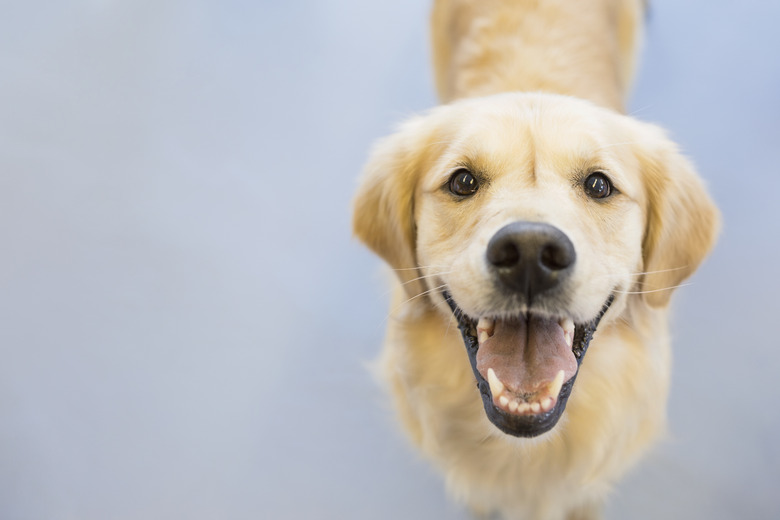What Could Cause Pus-Filled Bumps On Dogs?
We may receive a commission on purchases made from links.
Disclosure: At Cuteness, we are committed to being the go-to resource for pet owners and animal lovers. We only recommend products we think our audience will love. If you purchase something by clicking on one of these links, we may receive a small commission of the sale and the retailer might receive some data for accounting purposes.
As a great dog owner, you want your pup to be healthy and happy. It can be concerning when you spot something unusual going on with your dog, and many dog owners worry about unusual growths on their dogs. If you run your hand over your dog one day to discover a pus-filled bump, don't panic. There are actually a number of potential causes for these bumps in dogs, and while some veterinary treatment may be needed, most of these bumps are really pretty harmless.
What are abscesses?
What are abscesses?
If your dog seemed to develop a warm swelling overnight, it could be an abscess. Abscesses, pockets of pus that can be located just about anywhere on your dog's body, can develop very quickly and vary in size. They can be firm to the touch or may feel like they're filled with water, but generally, abscesses are painful to your dog, so be careful when you're inspecting the area.
Abscesses can be caused by any number of things, including a bite from an animal or a puncture wound that allows bacteria to work its way into your dog's body. The bacteria then cause infection and the pus-filled abscess results. If you find an abscess on your dog, take her to the vet. Depending on the severity of the abscess, the vet may prescribe antibiotics and some medication for pain relief. In some cases, it may be necessary to drain the abscess and monitor its healing.
What are cysts?
What are cysts?
Unlike abscesses, canine cysts grow more slowly. Cysts develop a lining and are filled with either a liquid or a more solid, cheese-like material called keratin. There are many different kinds of cysts, and they are caused by any number of issues, including an injury, a blocked hair follicle, and even sun radiation damage. Some breeds, like the Schnauzer, are predisposed to developing cysts.
Your vet will diagnose a cyst by performing a biopsy and testing the tissue. Rarely, cysts can be cancerous, so your vet will perform some tests to rule out any chance of cancer. When it comes to addressing the cyst itself, your vet may remove the entire cyst. The ideal treatment method will depend on the size and type of cysts that your dog has. Treatment often involves surgical removal, laser treatments, or the use of topical medications to shrink the cyst.
What is pyoderma?
What is pyoderma?
Pus-filled blisters are a symptom of another skin condition in dogs called pyoderma. This bacterial skin infection causes all sorts of issues that make your dog uncomfortable, including a rash, scaly skin, itching, redness, and those pus-filled blisters. It often occurs on areas of your dog where the hair is minimal.
Your dog will need some veterinary treatment if he's dealing with a case of pyoderma. Your vet will examine your dog's skin and may do a bacterial test to determine how to treat your dog's case best. Oral antibiotics are the most common course of treatment. Your vet may also prescribe some topical medications and special shampoos to help get your dog feeling better.
Understand canine acne
Understand canine acne
If you see multiple, small bumps around your dog's lips, chin, and muzzle, your dog might have a case of canine acne. No, acne isn't just for humans. Dogs (and cats) can get it, too. In dogs, acne often starts off as small, hard, red, raised areas. With a little time, these bumps can become swollen, inflamed, and pus-filled. As you can imagine, they're pretty painful for your dog, too.
In some cases, canine acne can resolve on its own, but more severe cases won't necessarily go away without treatment. If that's the case, or if your dog seems uncomfortable, then it's time for a trip to your vet. Your vet may prescribe topical or oral antibiotics to get the acne under control and get your dog feeling better quickly. Dogs often develop acne during their teenage years, so it's possible that your dog will outgrow the problem altogether.
Stop the itch
Stop the itch
A small pus-filled bump could also be due to a spider bite, a local reaction to an insect bite, or even inflamed hair follicles. Your dog could scratch open skin irritations in an effort to relieve itching, causing infected, pus-filled bumps to appear.
Over-the-counter products can help relieve your dog's itchiness to prevent further inflammation and skin bumps. Shop on Amazon for products such as antibacterial and antifungal shampoo to cleanse your dog from microbes that cause fungal invasions, yeast infections, ringworm, pyoderma, and bacterial itching.
Use flea and tick treatments to prevent these pests from biting and soothe hot spots and other skin itching with soothing veterinary-formulated spray. Eliminate allergens from your dog's diet and supplement with skin-nourshing ingredients such as salmon oil and probiotics.
Always check with your veterinarian before changing your pet's diet, medication, or physical activity routines. This information is not a substitute for a vet's opinion.
